Ah, mobile game marketing — where dreams can be crushed if you don’t grab the attention of players quicker than it takes for a TikTok dance trend to boom and bust. If you thought developing a game was hard, just wait until you try to get people to actually play it.
Between ever-changing privacy rules, rising ad costs, and a market more saturated than a gamer’s games library after a flash sale, it’s a battlefield out there.
But fear not! Where there’s chaos, there’s also opportunity — if you know where to look. So, grab your energy drink of choice and buckle up, because we’re about to break down what it really takes to survive (and thrive) in mobile game marketing.
Chapters
Mobile Game Marketing: Where Chaos Meets Opportunity
Welcome to the wild, ever-evolving battlefield of mobile game marketing, where developers and marketers alike must navigate two rapidly shifting industries: mobile gaming and mobile marketing. Both industries have been in a state of upheaval, thanks to privacy policies throwing a wrench into traditional advertising, the post-pandemic engagement slump, fragmentation in distribution platforms, and the rise of cross-platform gaming.
So, how do you survive and — dare we say — thrive in this madness? Let’s find out!
The Mobile Game Industry: A World of Opportunity (and Competition)
Once upon a time (read: 2009), the iPhone and App Store revolutionized gaming by putting entertainment in everyone’s pocket. Fast forward to today, and mobile gaming is the undisputed king of the entertainment industry, with hits like Candy Crush Saga, Genshin Impact, Angry Birds, Pokémon Go, and Clash of Clans dominating screens worldwide.
Here’s a quick look at current trends impacting the mobile gaming space:
😷 Pandemic Boom & Bust: COVID-19 temporarily supercharged mobile gaming engagement. People were stuck at home, swiping and tapping away their existential dread. But now that the world has reopened, reality has hit: mobile game revenue dropped significantly in 2022 — and has been recovering ever since. Translation? If your game isn’t pulling its weight in acquisition, retention, and monetization, it’s going to be a bumpy ride.
👑 Contenders to the App Store Duopoly: It used to be just Google and Apple, but the Epic Games Store has made major strides (both in legal battles and offerings) in becoming a viable app store in recent years. While its gaming catalogue is still rather small compared to the giants, it is making inroads – especially with its own dedicated and exclusive IP, such as Fortnite. Additionally, as the lines between mobile gaming, PC gaming, and console gaming blur, Steam has become a bit of a competitor to traditional mobile app stores, as well. That brings us to our next point…
📈 The Rise of Cross-Platform Gaming: Nowadays, more and more games are becoming platform agnostic – with players able to hop between playing on console, PC, and mobile devices. This has allowed mobile games to reach audiences that would have been impossible to grab previously. But in some ways, it also means more competition, as PC and console game publishers offer mobile gaming experiences.

The Mobile Marketing Industry: A Privacy-Pocalypse
Meanwhile, the mobile marketing industry has been dealing with its own set of nightmares. If you thought Apple’s App Tracking Transparency (ATT) was just a minor inconvenience, think again. It nuked traditional tracking methods, making it harder to effectively target users. Google plans to follow suit (eventually…), meaning user acquisition (UA) strategies that once worked like a charm are now an uphill battle.
Here’s the hard truth:
🚫 Granular user tracking? Dead. With increasing privacy regulations, such as Apple’s App Tracking Transparency (ATT) and Google’s Privacy Sandbox, advertisers and marketers have lost access to detailed user data that was once the backbone of precise targeting. This means that collecting granular user insights — like individual device IDs or behavioral tracking across multiple apps — is no longer viable at scale. As a result, marketing teams must adapt by leveraging aggregate data models, contextual targeting, and first-party data to maintain effectiveness.
🎯 Hyper-targeted ads? We wish. The loss of granular tracking directly impacts the ability to run hyper-targeted ads. Previously, advertisers could serve highly personalized ads based on detailed user profiles, purchase history, and in-app behaviors. However, without access to specific user data, ad platforms now rely on broader audience segments and machine learning-driven predictive models. This shift has led to less precise targeting and, often, lower ad performance, forcing marketers to invest more in creative testing and alternative targeting strategies.
💸 Rising ad costs? You bet. As a result of reduced targeting precision and increased competition for high-value users, cost-per-install (CPI) and cost-per-action (CPA) rates have surged. With less efficient targeting, advertisers must spend more to reach the right audience, often leading to inflated acquisition costs. Additionally, walled gardens like Meta, Google, and TikTok have more control over their ad ecosystems, allowing them to charge premium rates for inventory. This forces businesses to rethink their user acquisition strategies, incorporating organic growth tactics, influencer partnerships, and retention-focused monetization models to sustain profitability.
But, as we’ve said, where there’s chaos, there’s opportunity. The key to survival is mastering the new rules of engagement in mobile game marketing. That means leaning on scenario planning, soft launches, multi-channel acquisition strategies, and a relentless focus on creative optimization.
Marketing and Game Development: You Can’t Just Wing It
Look, we get it — game development is an art, a passion, a labor of love. But here’s the harsh truth: if you’re not thinking about marketing from day one, your game is probably going to sink into the abyss of forgotten apps faster than you can say “free-to-play.”
Marketing isn’t some last-minute thing you slap on at launch — it’s a fundamental part of game development itself. If you want your game to be more than a blip on the app store radar, you need a marketing strategy baked in from the start.
Know Your Players, Your Rivals, and Your Ecosystem
Before you even start coding, you need to figure out who you’re making this game for. And no, “everyone” is not a target audience. Nor are all app stores made equal for all games.
Market Research: Find Your Goldmine Before You Start Digging
The mobile game industry is a battlefield, and guess what? Most of the real estate is already claimed. The trick is finding the niches that aren’t oversaturated and developing a game that serves a hungry, underserved audience.
- Dive into genres, regions, and player archetypes. Are there under-tapped markets where your game could thrive? Maybe it’s strategy games in Latin America or idle games for Gen X players — the point is, find a niche and own it.
- Use data-driven tools. Services like Apptopia and SensorTower (with Data.ai) can give you insights into what’s trending and where the gaps are.
- Don’t just copy what’s hot. Chasing the latest hypercasual or battle royale trend might work — until the next flavor-of-the-month steals your thunder. Instead, focus on making something sustainable and scalable.
Target Audience: Stop Guessing and Start Defining
Your target audience is way more than just “casual” or “hardcore” gamers. You need real, data-backed personas that tell you who your players are, what they like, and why they play.
Here’s how to dial in your audience:
- Start with Demographics & Psychographics
- Age: Are you targeting teens on TikTok or older gamers with disposable income?
- Geography: Are you launching globally, or are you focusing on high-ARPU markets like Japan or the US?
- Interests & Behavior: What kind of art style, music, or mechanics resonate with them?
- Devices & Play Habits: Are they playing on high-end iPhones or budget Androids? Do they binge-play or prefer short gaming sessions?
- Create Player Personas
Once you’ve gathered data, build actual personas that represent your ideal players. For example:
🕵️ Persona 1: The Mid-Core Grinder
- 28-year-old male, USA
- Works a 9-to-5, plays on his commute and after dinner
- Enjoys RPG progression, collecting characters, and limited-time events
- Prefers battle passes over gacha randomness
🎮 Persona 2: The Hypercasual Dabbler
- 35-year-old female, Brazil
- Plays in short bursts while waiting for coffee or in between meetings
- Prefers simple, one-tap mechanics over complex narratives
- Engages with rewarded ads but rarely makes in-app purchases
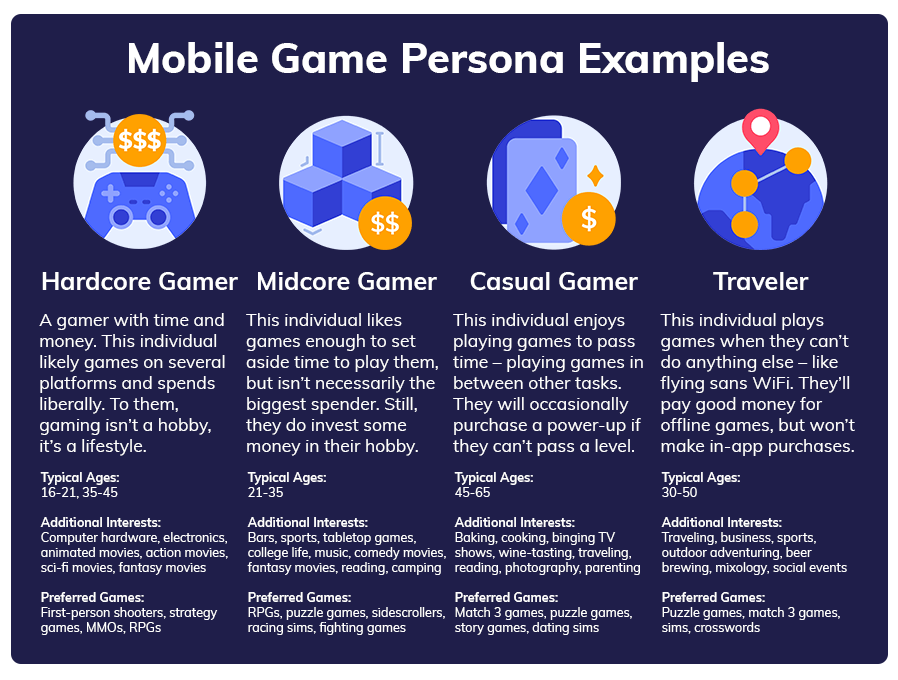
- Test Different Audiences Early
Even if you think you know your audience, you don’t. Not yet.
- Run small-scale ad campaigns targeting different demographics to see who actually converts.
- Test different creatives to see what resonates (do they click on fantasy artwork or bright, cartoony visuals?).
- Pay attention to early engagement data — who’s sticking around past Day 1? Day 7?
💡 Pro Tip: Don’t be afraid to pivot. If a different audience is engaging more than your expected one, adjust your messaging and lean into what’s working.
Competitor Research: Learn From Your Rivals Like a Pro
Once you know your audience, it’s time to stalk the competition (ethically, of course).
- Play their games. See what works, what sucks, and where you can do better.
- Read user reviews. Players are not shy about what they hate. Get ahead of mistakes others have made and capitalize on their weak points in ads.
- Study their marketing. What kind of ads do they run? What social channels are they using? How are they pricing their in-app purchases?
TL;DR: Do your homework. The more you know about your competition, the easier it will be to outmaneuver them.
App Store Research: Know The Differences
Not all app stores are created equal. They vary widely in who they cater to, what apps they provide, what kind of users frequent them, and more. For instance:
- Apple App Store users tend to spend more (freemium thrives here).
- Profitable Android games are often more ad-driven (users are thrifty).
- Steam is a haven for hardcore gamers (premium monetization works).
That said, both freemium and premium games can do well in any mobile app store. And a multi-platform approach typically casts the widest net to reel in the most users. Additionally, cross-platform gaming is beginning to become the standard nowadays.
So a multi-platform approach may make the most sense. However, here’s a free pro tip: Do a cost-benefit analysis before committing to multiple platforms! A bad port is worse than no port at all.
Pre-Launch and Game Launch Marketing: How to Not Flop
Alright, so you’ve got a game. Fantastic. But if you think that just putting it in the app store and hoping people magically find it is a viable strategy, think again. This is mobile gaming, not a lemonade stand. You need a marketing plan that works before, during, and after launch to actually get players in the door.
Pre-Launch Phase — Setting Up the Infrastructure
The pre-launch phase is where you set up the pipes, wires, and marketing magic that will prevent your game from disappearing into the void.
Nail Your Technical Plumbing
Before spending a cent on ads, make sure your SDKs, data telemetry, and tracking tools are actually working. There’s nothing more tragic than burning your ad budget and realizing two weeks later that your attribution data is borked. Your devs need to:
✅ Integrate SDKs and analytics tools correctly. Ensure that all third-party tools for attribution, in-app analytics, and user segmentation are properly integrated.
✅ Set up dashboards for UA tracking. Build real-time reporting dashboards to track installs, retention rates, and user engagement metrics across different traffic sources.
✅ QA test the heck out of everything. Conduct rigorous testing to verify data integrity, making sure event tracking works flawlessly before you spend money on acquisition.
If you don’t get this right, all your marketing efforts will be based on garbage data. Don’t be that team.
Soft Launch: The Crucial “Don’t Embarrass Yourself” Phase
A soft launch is your game’s dress rehearsal. Ignore this phase at your own peril. This is where you gather data, squash bugs, and figure out if people actually want to play your game.

What You Need to Do in Soft Launch
- Technical Test — This phase focuses on ensuring the game is technically sound. You’ll need to test for server stability, load balancing, and overall performance. Can your infrastructure handle peak traffic? Are there latency issues affecting gameplay? Conduct stress tests with concurrent users to simulate real-world conditions. Make sure crash rates remain low and that any game-breaking bugs are resolved before moving forward. If your game doesn’t work, fix it!
- Retention Test — This is where you determine if your game is engaging enough to keep players coming back. Monitor key retention metrics at Day 1, Day 7, and Day 30 to track player stickiness. Look for drop-off points in the game experience — are users quitting after a tutorial? Is progression too slow? Use A/B testing to optimize onboarding and engagement loops, ensuring that early interactions with the game are compelling. If your retention numbers suck, your game probably isn’t fun.
- Monetization Test — Analyze whether your monetization strategy is working. Track Average Revenue Per User (ARPU), Lifetime Value (LTV), and conversion rates for in-app purchases and ads. Are players making purchases, or are they bouncing due to poor pricing models? Experiment with different in-game economies, offer limited-time deals, and analyze purchase funnel drop-offs. Ensure monetization does not interfere with the core gameplay experience, as aggressive monetization can lead to churn.
Pro Tip: Avoid Data Volatility
Stop using highly variable ad networks (Google Ads, IronSource, etc.) in soft launch. Use stable sources like Meta or TikTok to get clean, representative data.
Most importantly, be brutally honest about your results. If people aren’t sticking around, don’t blame the algorithm. Fix your game.
Global Launch: Scaling Like a Pro
Congrats, you made it past the soft launch without a total disaster. Now it’s time to scale. Scenario Planning = Your Safety Net! Before you launch worldwide, plan for different realities (so you don’t set your money on fire):
🔥 Bull Case (Everything is amazing, you scale aggressively)
😐 Mid Case (an in-between scenario, cautious scaling)
💀 Bear Case (Your game flops, you cut losses and rethink GTM)
User Acquisition: How to Spend Money Smartly
If you’re throwing ad dollars around without a plan, stop. Focus on:
- First-Party Ad Channels — Meta, TikTok, and Snapchat rule. These platforms offer robust targeting, machine-learning-driven ad placements, and access to large, engaged audiences. Meta excels at interest-based targeting, TikTok thrives on trend-driven content that blends seamlessly with organic posts, and Snapchat is particularly effective for Gen Z-focused campaigns. Diversifying spend across these channels can help balance performance and mitigate ad fatigue.
- Rewarded Video Networks — IronSource and AppLovin are great for acquiring engaged players. These networks allow users to watch ads in exchange for in-game rewards, making them an effective way to monetize players while keeping engagement high. Since rewarded ads attract players who are already interacting with in-game content, they tend to have better conversion rates and can boost LTV. Make sure to experiment with placements and incentives to maximize their effectiveness.
- Creative Optimization — Ad fatigue is real. Refresh your creatives constantly. The best-performing ad creatives capture attention quickly, showcase key gameplay mechanics, and include strong calls to action. Leverage split testing to identify what resonates with different audience segments. Make sure to format each creative so it feels native to each platform. For instance, vertical UGC shorts work best on TikTok, while static ads can still perform well on Facebook.
Supporting Tactics: Don’t Just Rely on Ads
Ad spend alone won’t save you. Here’s what else you should be doing:
- Influencers & Content Creators: Partner with gaming influencers on Twitch, YouTube, and TikTok to showcase gameplay, provide reviews, and build credibility among niche audiences. This is particularly effective for PC and console games, but it’s still worth testing for mobile games.
- Community Building: Foster engagement through Discord servers, Reddit threads, and the like. Engage in AMAs, share fan art, and respond to comments. These can supercharge organic growth. Take things a step further by creating exclusive content and in-game perks for community members to boost loyalty.
- Press & PR: Secure features on gaming news sites, pitch unique developer stories, and distribute press kits with compelling game assets to media outlets. Find your game’s unique angle and leverage it for coverage.
App Store Optimization: An Effective Marketing Lever
App store optimization (ASO) is the difference between being seen and being invisible. Your app store product page is your storefront. If it looks like a knockoff game from 2011, no one will install it.
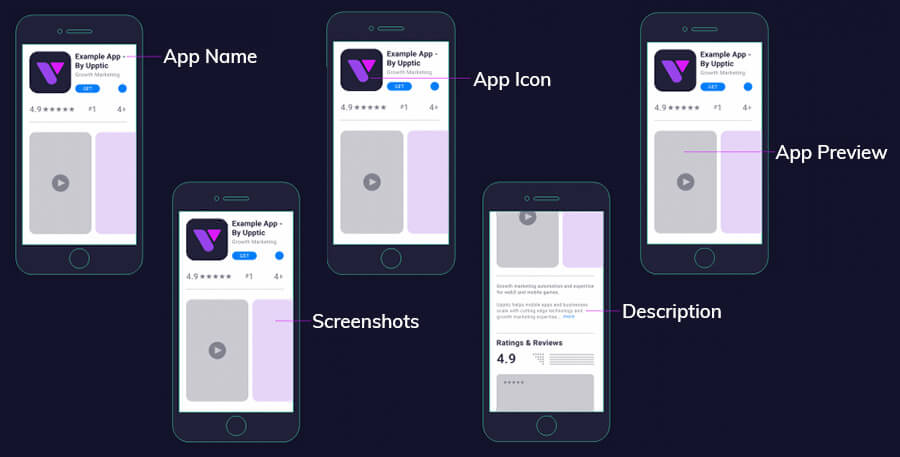
- App Icon & Name (Discoverability): Make it pop. Your app icon is the first thing potential users see, so ensure it’s eye-catching, memorable, and conveys the theme of your game at a glance. Bland, uninspired icons kill conversion rates.
- Keywords & Categories (Discoverability): If you don’t show up in searches, you don’t exist. Research high-volume, low-competition keywords and continuously test variations to improve search rankings.
- Screenshots, Video, Description (Conversion): Show the good stuff. Use high-quality in-game footage, focus on key action moments, and make sure the first few seconds of your preview video grab attention instantly. If your first screenshot is your login screen, rethink your life choices.
- Reviews and Ratings (Conversion): Your reviews and ratings aren’t just vanity metrics — they directly impact conversion rates and app store visibility. High ratings improve search rankings and increase trust, boosting installs. Negative reviews can tank your credibility if left unaddressed. Responding to negative reviews isn’t just about damage control; it’s about user retention and conversion. Acknowledging issues, providing solutions, and showing that you care about user feedback can turn frustrated players into loyal fans and significantly improve public perception.
Pro tip: Run search ads in the app stores you’re listed in (Apple Search Ads for Apple’s App Store and Google Ads for Google Play). These target people actively looking for games like yours, making them one of the highest intent traffic sources.
SEO & Content Marketing: Yes, It Actually Works
If you’re ignoring SEO, you’re missing out on free traffic.
- Blog about your game. Publish regular developer updates, behind-the-scenes insights, and expert gameplay strategies to attract organic traffic and establish authority in your niche.
- Publish guides and developer diaries. Offer tutorials, game tips, and deep dives into your creative process to engage both potential players and gaming journalists.
- Make sure your website ranks for relevant search terms. Optimize for SEO with targeted keywords, structured metadata, and backlinks from high-authority gaming sites.
Google is still a major discovery tool for gamers! Don’t miss out!
Master Paid Ads (So You Don’t Waste Your Budget)
With a never-ending carousel of ad formats, targeting options, and shifting platform standards, it’s enough to make even the most seasoned marketers dizzy. But don’t worry — we’ve got you covered. Let’s talk about ad formats, networks, influencers, and all the juicy details you need to ensure your ad dollars aren’t swirling down the drain.
The Heavy Hitters: Ad Formats That Work
All ads are not created equal, but all are necessary as part of a holistic marketing strategy. Here’s what you should focus on!
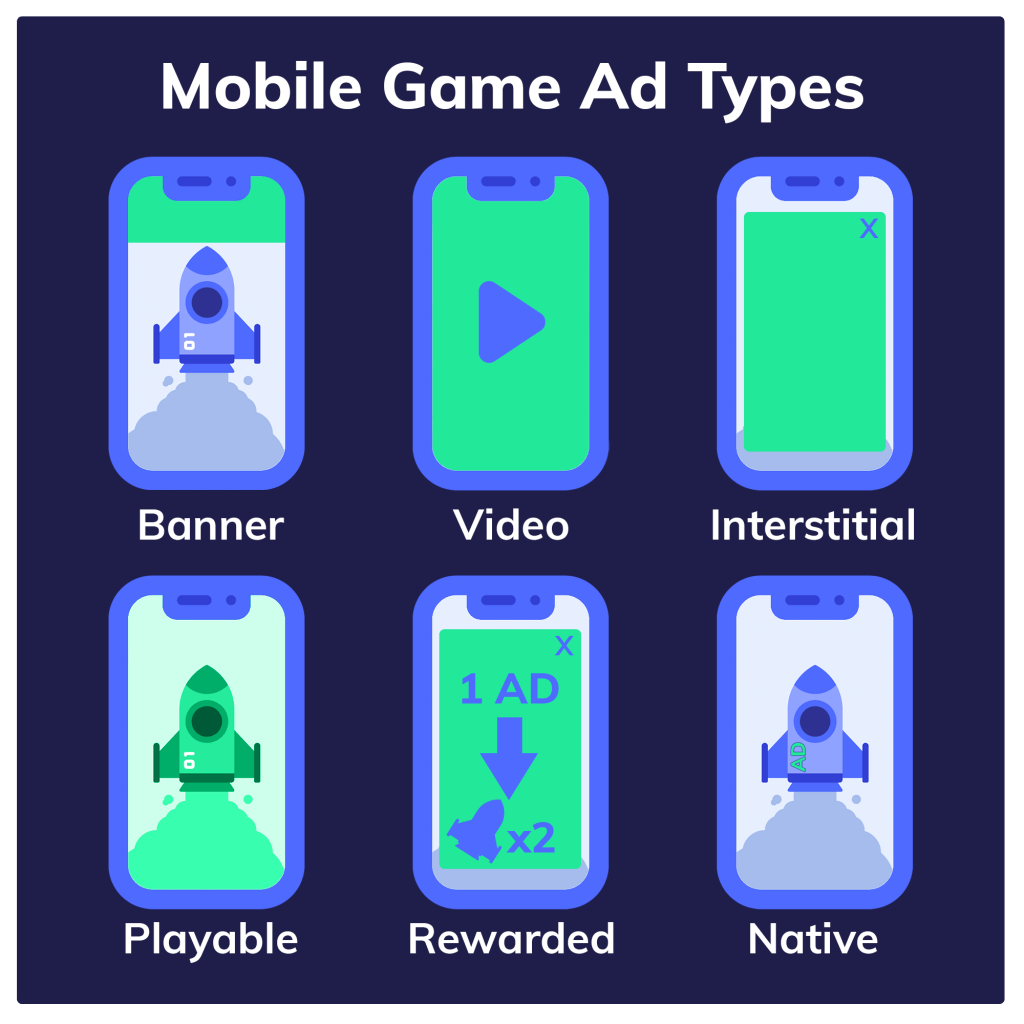
Video Ads & Rewarded Video Ads: Because Motion Sells
If a picture is worth a thousand words, then a video is worth a million downloads (okay, maybe not quite, but you get the idea). Video ads consistently outperform static images, and here’s why:
- They’re engaging. Video ads capture attention and increase conversions, if done well.
- They tell a story. A well-crafted video ad can highlight key game mechanics, narrative elements, and rewards.
- They showcase actual gameplay. Seeing is believing — potential players need to know what they’re getting into.
Pro Tips for Killer Video Ads:
- Spy on your competitors — analyzing top-performing ads in your genre can reveal creative trends and high-engagement styles.
- Keep it short and sweet — 15-30 seconds max to deliver a compelling message without losing attention.
- Use captions — because the vast majority of mobile users watch videos on mute.
- Grab attention in the first 3 seconds — your hook matters more than anything else.
- Include a CTA at the end — guide users toward downloading or engaging further.
Now, take video ads up a notch with rewarded video ads — where users actually want to watch because they get in-game goodies in return. Opt-in and engagement? Yes, please!
Extra Insights:
- Players are more likely to complete a rewarded video ad since they get an immediate benefit, making them a goldmine for in-app monetization.
- Tracking engagement metrics and tweaking incentives can optimize conversion rates and retention.
- Test different types of rewards to find what resonates best with your audience — currency, power-ups, exclusive content, etc.
Playable Ads: The Try-Before-You-Buy Hook
Want users who actually enjoy playing your game before they install it? Meet playable ads — interactive mini-demos that let users experience your gameplay firsthand.
But beware:
- A buggy or confusing playable ad is worse than no ad at all.
- Highlight the best, most engaging moment of your game.
- Make sure users leave with a sense of accomplishment, not frustration.
Bonus Tips:
- Playable ads have proven to increase retention since players already know what to expect before they download.
- Keep the mechanics simple — players should grasp the gameplay in under 10 seconds.
- Use an intuitive tutorial overlay to ease new users into the experience.
Static Ads: The Old Reliable (When Done Right)
Static ads — those banner ads you love to hate — still have a place in your marketing mix. The key? Keep them clean, clear, and compelling:
- Big, bold text for your main message.
- Strong branding so people know it’s you.
- A clear call-to-action (CTA) — “Download Now” is a no-brainer.
Pro Insights:
- Static ads work best when paired with highly targeted placements in relevant gaming environments.
- Optimize for different screen sizes — small, cluttered banners won’t convert well.
- A/B test colors and text styles to find the most eye-catching combinations.
Native Ads: The Genius of Blending In
Native ads don’t scream “HEY, I’M AN AD!” — and that’s the beauty of them. Whether it’s an in-game billboard or organic-feeling content from a streamer, native ads seamlessly integrate with the user’s experience.
If done right, players won’t even realize they’re being marketed to (until they suddenly have an uncontrollable urge to check out your game).
Why It Works:
- These ads don’t disrupt gameplay, leading to better engagement.
- High authenticity drives better click-through rates and conversions.
- Effective where influencer content naturally showcases your game.
Just remember that transparency is key! For example, even if a paid ad fits naturally into a streamer’s content, it’s always important to disclose paid advertisements to ensure players can build a sense of trust and transparency with your brand.
Search Ads: Showing Up When It Counts
Search ads (like Apple Search Ads or Google Play search ads) put your game right in front of people actively looking for something similar. These ads blend into search results but have a tiny “Ad” label for transparency. It’s low-key, but highly effective.
Optimization Tips:
- Test different keywords and bid strategies to maximize ROI.
- Use long-tail keywords to capture niche audiences with high intent.
- Use varied creatives (text vs. visual elements) to boost conversions.
Ad Networks: Your Shortcut to a Bigger Audience
Ad networks connect sell-side ad inventory suppliers (game publishers, social media platforms, websites, etc.) with buy-side advertisers who want to buy ad space (game publishers and game marketers). The best ones use real-time bidding (RTB) — a fancy way of saying the highest bidder wins the best placement in milliseconds.

Top Ad Networks to Know:
- Google, Meta, TikTok: The “big three” — these companies are the leading first-party ad platforms for gaming. They provide a broad reach and the ability to target specific audiences during ad campaigns.
- Unity and AppLovin: Unity Ads (with IronSource) and AppLovin are two of the top rewarded video networks around — leveraging in-app rewarded videos that provide a valuable way to acquire users who are already engaged in gaming.
- Smaller Networks: Platforms like Snapchat and Apple Search Ads are also valuable additions to a marketing mix, but have specific use cases (as noted above). Meanwhile, LiftOff (with Vungle) and Mintegral are also well-known in-app rewarded video networks, but have smaller inventories compared to AppLovin and Unity.
Influencer Marketing: Worth the Hype?
Spoiler alert: yes — but only if done right. Working with gaming influencers can skyrocket awareness, but there’s a catch:
- Follower count isn’t everything. Engagement matters more.
- Micro-influencers can have a bigger impact than a massive influencer who barely interacts with their audience.
- Long-term relationships win. One-time shoutouts feel forced. Ongoing brand ambassadorships build credibility and trust.
Insider Tips:
- Influencer marketing works best when combined with a strong community-building strategy, ensuring long-term engagement rather than one-off spikes.
- Focus on creators whose content aligns with your game’s theme and audience.
- Track performance metrics beyond views — engagement, conversion rates, and retention matter.
Test, Measure, Repeat: The Only Growth Strategy That Works
No matter what ad formats or platforms you use, constant iteration is the name of the game.
- A/B test (split test) like your business depends on it (it does).
- Measure results — not just clicks, but actual conversions.
- Adapt to ad fatigue — users will get bored, so stay fresh.
Extra Strategy:
- Use machine learning-based tools to automate and optimize ad variations based on real-time performance data.
- Experiment with different value propositions — what message resonates most with your audience?
Organic Engagement: Because Paid Ads Only Go So Far
Paid acquisition spikes downloads but doesn’t build loyalty — and as soon as the money stops flowing, so do the installs. Organic engagement creates superfans, visibility, and word-of-mouth that continues paying dividends long after hitting “post.”
The key? Be consistent, be authentic, and actually give a damn about your audience. If you engage with them genuinely, they’ll engage right back — and bring their friends along for the ride. Here’s how to master organic engagement so your game can build hype, foster loyalty, and get players who actually care about it.
Channel Distribution: Pick Wisely
Being everywhere sounds cool in theory but is a one-way ticket to burnout and irrelevance. Instead of spreading yourself thin, pick the platforms that give you the best ROI — where your target audience already hangs out.
🔍 How do you find that out?
- Stalk your competitors. If they’re crushing it on TikTok but crickets on X (formerly Twitter), you have your answer. Research competitor engagement, the type of content they produce, and what resonates with their audience.
- Use analytics tools (even free ones like Meta’s Business Suite or TikTok’s Creator Dashboard) to track engagement, click-throughs, and retention. This data helps fine-tune your strategy based on real metrics.
- Test different platforms with controlled user cohorts before committing to a full-scale engagement strategy. This allows you to identify the most effective channels for organic reach.
🔥 Pro Tip: Instead of being everywhere, be omnipresent in one or two places where your audience actually lives. Mastering a few key platforms will yield better results than trying to be everywhere at once.
Social Media: Play the Algorithm Like a Pro
Social media isn’t just about spamming content and hoping for the best. Each platform has its own unspoken rules — and breaking them means getting buried in obscurity.
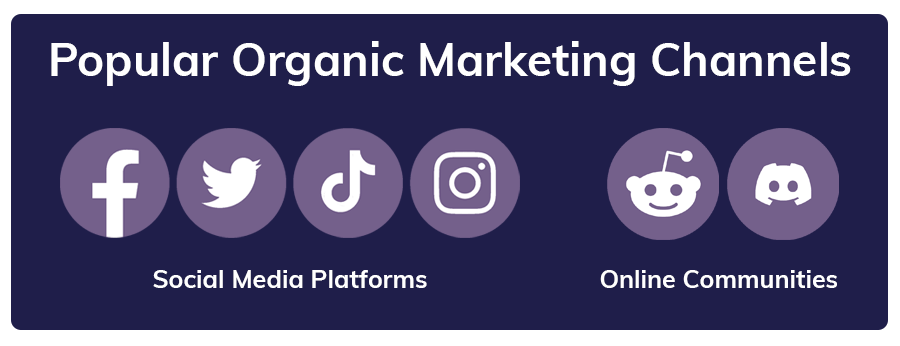
Platform-Specific Best Practices:
🎥 TikTok, Instagram, YouTube:
- Make it authentic — scripted videos flop; raw, funny, or bizarrely relatable content wins. Players appreciate authenticity over polished marketing.
- Leverage trends — but make them gaming-relevant. Adapt popular trends in a way that fits your game’s theme and audience.
📸 Instagram & X (formerly Twitter):
- Visual-heavy posts win (think high-quality in-game shots, sneak peeks, dev behind-the-scenes). Engage players with content that builds anticipation.
- DMs are gold — respond to comments, DMs, and tags religiously. Building relationships with engaged users leads to organic growth.
💊 Reddit & Discord:
- Authenticity is king. Shilling gets you banned. Instead, contribute to discussions in a meaningful way.
- Engagement over broadcasting. Instead of dumping links, ask questions, share cool tidbits, and actually respond to people. Establish credibility and trust within the community.
👎 What NOT to do:
- Posting and ghosting. If you’re not responding to comments, why are you even there?
- Cross-posting the same content across platforms without optimizing it for each one. Adjust content format and messaging for each platform.
- Treating social media like an ad board instead of a two-way conversation. Users want to engage, not be sold to.
🔥 Pro Tip: Your goal isn’t just engagement — it’s community-building. The stronger your core audience, the more organic traction you’ll get.
Communities: Your Free Hype Machine
If social media is the front-facing engagement tool, communities are where the real magic happens. Players love feeling like they’re part of something bigger — so give them that!
Where to Build a Community?
💬 Discord: Your best bet for real-time engagement. Start with a small, tight-knit group before opening it to the public. Use Discord bots for gamification to keep engagement high.
📢 Reddit: Gamers love Reddit. Whether it’s a dedicated subreddit or hopping into existing communities, Reddit can be a valuable boon to your game. Share developer insights, host AMA sessions, and build community-driven events.
📺 Twitch & YouTube: Not just for streaming games — use them for developer Q&As, AMAs, and sneak peeks. Live interactions build strong, loyal communities.
ASO & SEO: Making Sure Players Find You
A killer game means nothing if no one can find it. That’s where App Store Optimization (ASO) and Search Engine Optimization (SEO) come in.
🛒 ASO Best Practices:
- App title & description: Use keyword-rich descriptions and compelling app titles that clearly define your game.
- Screenshots & videos: Showcase your best features with engaging visuals that highlight the game’s experience.
- Reviews & ratings: Encourage positive reviews to improve rankings and attract new players, and respond to bad reviews to retain current players.
- A/B testing / split testing: Continuously optimize your app store page by testing different creative elements.
🔎 SEO Best Practices:
- Gaming-related keywords: Target niche and long-tail keywords to attract engaged players.
- High-quality backlinks: Partner with gaming blogs, influencers, and websites to improve your search ranking.
- Content-driven SEO: Publish guides, FAQs, and blogs that enhance discoverability and value.
- Technical SEO: Optimize website speed, mobile-friendliness, and meta descriptions for better indexing.
Content Marketing: Keeping Players Hooked
Engaging players outside of the game keeps them coming back. Typically, good content marketing also increases SEO and increases visibility among prospective players, too!
📝 Types of Content to Create:
- Developer blogs: Share behind-the-scenes stories and game development insights to build community trust.
- Game strategy guides: Help players level up with well-structured game tutorials and how-to articles.
- Video content: Create engaging trailers, patch notes breakdowns, and Q&A sessions to drive hype.
- Influencer collaborations: Work with gaming influencers to create authentic content that extends your reach.
🔥 Pro Tip: Consistency wins. A steady flow of content keeps your game top-of-mind even when players aren’t actively gaming.
Data & Analytics: The Ultimate Power-Up
Alright, marketers, if you’ve made it this far, you already know that data isn’t just a bunch of boring numbers — it’s the key to outsmarting the competition, optimizing your game’s performance, and making your user acquisition (UA) budget actually work for you. Let’s dive into the nitty-gritty of measurement, attribution, and media buying models without putting you to sleep.
Mobile Marketing Attribution: Who Gets Credit for Your Wins?
Attribution is basically the referee in the marketing game, making sure credit goes where it’s due. Without it, you’re throwing money at ads and praying they work. The most common methodologies include:
- First-Touch Attribution: The first ad a user interacts with gets all the credit. (Cool, but what about everything that happened after?)
- Last-Touch Attribution: The last ad before conversion gets credit. (Most common in mobile games, but not always the full story.)
- Multi-Touch Attribution: Distributes credit across multiple touchpoints. (A marketer’s dream, but privacy regulations make this harder.)
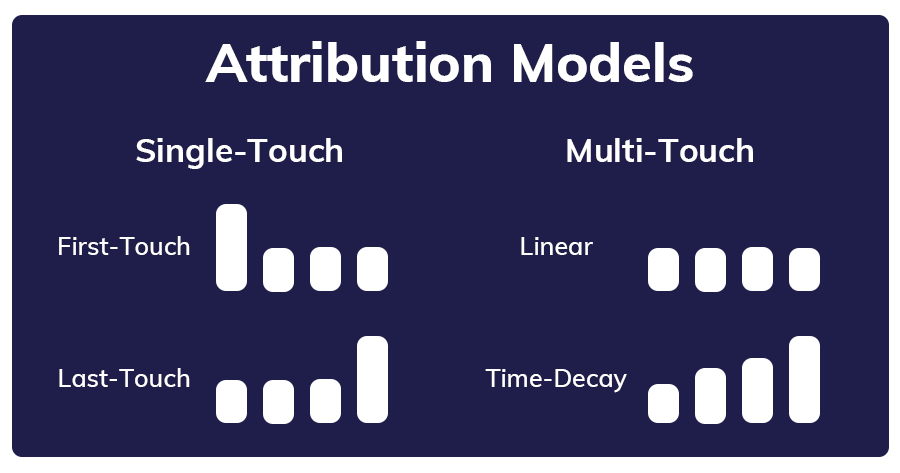
The Impact of ATT and SKAN on Attribution
Thanks to Apple’s App Tracking Transparency (ATT) and SKAdNetwork (SKAN), the UA world has been flipped on its head. Now, marketers have to actually convince users to opt-in to data tracking (gasp!). Part of the solution is to use compelling pre-prompts and make a strong case for why you need to track players. The other part of the solution lies in modeling and projections (which we’ll get to later – and which Upptic can help with).
Organic Uplift: The Snowball Effect of Smart UA
You paid for one install, but what if that install leads to five more free installs? That’s the magic of organic uplift. Organic uplift happens when paid installs boost your rankings, get you more visibility, and lead to organic installs.
For instance, if you effectively use paid ads to boost installs and chart high in app stores, the installs that come from the increased visibility of topping the charts are examples of organic uplift! Similarly, someone who sees your ad, but doesn’t click on it, but then later downloads your game, can’t be counted as an attributable install – making them another example of organic uplift! Any word-of-mouth marketing from someone who installed your game after seeing a paid ad would also count as organic uplift!
Measuring organic traffic is essential for forming a complete picture of your users and their habits and behaviors. That said, it can be difficult to measure.
The trick? Be obsessive! The easiest way to measure organic traffic is to be meticulous in tracking all installs and then removing paid installs from the equation to learn more about your organic traffic.
Media Buying Models: How Much Are You Paying to Play?
You wouldn’t just buy an expensive power-up without knowing what it does, right? The same goes for ad spend. Here’s the breakdown of the major media buying models:
- CPC (Cost Per Click): Pay for clicks. Great for traffic; risky if conversions aren’t there.
- CPM (Cost Per Mille): Pay per 1,000 ad impressions. Awesome for brand awareness, not so much for installs.
- CPI (Cost Per Install): Pay only when someone installs your game. Good for pure acquisition, but user quality varies.
- CPA (Cost Per Action): Pay when users take a specific action. Best for high-intent behaviors, like completing a tutorial or making a purchase.
- Important Note! CPA can also sometimes mean “Cost Per Acquisition” – which is often interchangeable with CPI in the context of app marketing and game marketing.
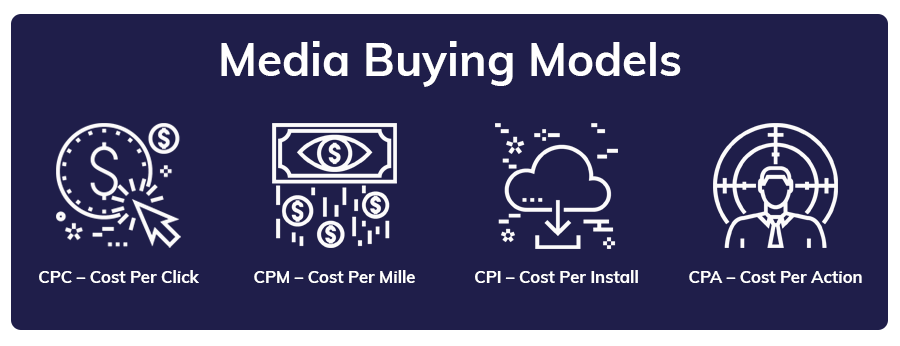
Your goal? Mix and match these models to keep user acquisition efficient and scalable.
Modeling for Incomplete Data: Because No One Has All the Answers
ATT, SKAN, and privacy changes mean one thing: You’re never going to have perfect data again. So how do you make smart decisions? Enter Marketing Mix Modeling, sometimes known as Media Mix Modeling (MMM).
MMM looks at all your marketing efforts, the money you’re spending, and the results you’re getting to predict performance and optimize spend. It helps answer questions like:
- How much would I spend to see a 10% increase in installs?
- Which channels are actually bringing in quality players?
- How can I balance my budget for the best ROI?
Any media mix model should include all the marketing channels you’re using, the money you’re spending on each channel, and the results of that spend.
Cross-Platform Analytics: Because Gamers Aren’t Siloed
Players aren’t sticking to one platform anymore — they’re bouncing between mobile, PC, and console. If you don’t have a cross-platform game, you’re potentially missing out on a gigantic segment of prospective players. And if you do have a cross-platform game, but you’re not tracking behavior across platforms, you’re missing half the picture.
Challenges?
- Different APIs, different data formats, different everything.
- Privacy regulations that limit what you can track.
- The need for standardization so data actually makes sense.
Solutions?
- Use first-party data (your golden ticket).
- Integrate cross-platform analytics tools like AppsFlyer or Adjust.
- Make sure your reporting is seamless across platforms.
The Best Tools for the Job
The internet is overflowing with analytics tools, but these are the ones that actually matter:
- Attribution & Analytics: AppsFlyer (for mobile), Adjust (for mobile), Singular (for mobile), Gamesight (for PC), Upptic (for full-spectrum data analysis)
- Platforms: These platforms typically provide measurement tools – with at least a few buying models as well: Meta, TikTok, Google Ads, Apple Search Ads, IronSource / Unity, AppLovin
Key Takeaways for Mobile Game Marketing
Building a thriving game userbase isn’t magic — it’s strategy, patience, and a whole lot of hustle. Spoiler alert: One marketing channel won’t cut it. And no, throwing cash at ads won’t make your game the next big thing.
You need a smart mix of organic and paid growth, working together like a well-oiled machine. Track your ROAS (return on ad spend) like your success depends on it — because it does. Every dollar should be pulling its weight, and if it’s not? Time to pivot.
Oh, and you can’t do this solo. Growth takes partners — agencies, ad platforms, influencers, or all of the above. The right allies make all the difference.
Lucky for you, we at Upptic live for this stuff. Ready to level up? Let’s talk.
Keep up with the latest insights from Upptic
Sign up for our monthly newsletter

